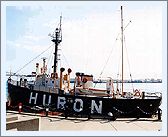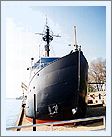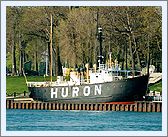|
Historical Information

Lightship 103, "Huron" began
her life in the Consolidated Shipbuilding Co in Morris Heights New York,
with the laying of her keel in 1918. She was completed in 1920 at a cost of
$147,428. 96 1/2 feet in length, 24 feet in the
beam, drawing 9 1/2 feet, and weighing 312 tons,103 was powered by a
single compound reciprocating steam engine fired by two coal-fired
Scotch boilers, developing one hundred and seventy-five horsepower.
In order to ascertain her
seaworthiness, she steamed under
her own power to Maine, where on May 18 she and lightship LV99 were met
by the tender HIBISCUS and towed to the entrance of the St Lawrence
River. Both lightships then steamed under their own power to
Ogdensburg, New York, where they were met by the tender Crocus, and
escorted to Detroit.
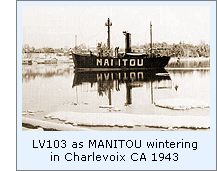 The Huron then continued on under her
own power to the Twelfth District Headquarters in Milwaukee, where she
arrived on June 9th. Sported a bright red Hull with the word
"RELIEF" painted on her hull sides, indicative of the purpose
for which she was originally commissioned. In addition to general relief service
throughout Lakes Michigan and Superior, Huron spent the 1924, 1925, 1926
and 1929 seasons guarding Grays Reef, and the 1934 and 1935 seasons on
North Manitou Shoal. The Huron then continued on under her
own power to the Twelfth District Headquarters in Milwaukee, where she
arrived on June 9th. Sported a bright red Hull with the word
"RELIEF" painted on her hull sides, indicative of the purpose
for which she was originally commissioned. In addition to general relief service
throughout Lakes Michigan and Superior, Huron spent the 1924, 1925, 1926
and 1929 seasons guarding Grays Reef, and the 1934 and 1935 seasons on
North Manitou Shoal.
She was transferred to the Eleventh
District in 1935 for one year, where she once again saw duty as a relief
ship. In 1936, her hull was repainted black, and she was transferred to
permanent duty guarding the Corsica Shoals, off the mouth of the St.
Clair River.
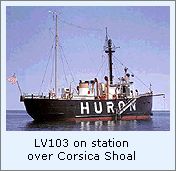 While on Corsica Shoal, she was chained
to a huge 6,000-pound mushroom anchor. She was equipped with Diloc
anchor chain, a particularly strong and heavy chain of which each link
weighed 14 pounds. She carried 450 feet of this chain onboard, of which
only 180 feet were used to anchor on Corsica Shoal, due to the
shallowness of the area. Typically, her eleven to twelve man
crew remained on station at
Corsica Shoal from early April until late December, and then took her to
winter at the
Coast Guard Station in Detroit at the foot of Mt. Elliot. In 1948, she was converted to diesel
power at a cost of $168,000 with the installation of twin six-cylinder
GM 6-71 engines at the DeFoe Shipbuilding Company of West Bay City,
Michigan. With this conversion, she had a top speed of nine knots. While on Corsica Shoal, she was chained
to a huge 6,000-pound mushroom anchor. She was equipped with Diloc
anchor chain, a particularly strong and heavy chain of which each link
weighed 14 pounds. She carried 450 feet of this chain onboard, of which
only 180 feet were used to anchor on Corsica Shoal, due to the
shallowness of the area. Typically, her eleven to twelve man
crew remained on station at
Corsica Shoal from early April until late December, and then took her to
winter at the
Coast Guard Station in Detroit at the foot of Mt. Elliot. In 1948, she was converted to diesel
power at a cost of $168,000 with the installation of twin six-cylinder
GM 6-71 engines at the DeFoe Shipbuilding Company of West Bay City,
Michigan. With this conversion, she had a top speed of nine knots.
On August 20, 1970 she raised her
anchor from Corsica Shoal for the last time. Replaced by a lighted buoy,
she was the final remaining Great Lakes lightship, and with her
departure a long and honorable tradition came to an end.
She was decommissioned at Detroit on
August 25th of that year, and transferred to the City Of Port Huron on June 5
of 1971. Towed by tug to Port Huron, she was moved into a
pre-built seawall which was sealed behind her, and filled-in with dirt,
giving her a permanent berth on the shore of the St. Clair River in Pine
River Park.
A large door was cut into her port side in the area of
the Crew's lounge, and the process of converting her into a museum was
begun. Dedicated on October 4, 1974, today she serves as a proud
monument to the men who served on her through her fifty long years of
service.

Seeing this Light

Huron Lightship Museum at Pine Grove Park, Port Huron, Michigan, is
located just south of the Blue Water Bridges on the St. Clair River, and
is open to the public from April through mid December.

Contact
information

The Port Huron Museum con be contacted at:
1115 Sixth St., Port Huron, MI 48060
Telephone (810) 982-0891, extension 19

 Reference
Sources Reference
Sources

Port Huron Museum website
USCG Lightship Listing.
Huron Lightship Museum website,
Personal visit to Port Huron, 05/05/2000
Photographs from the author's personal collection.
|
